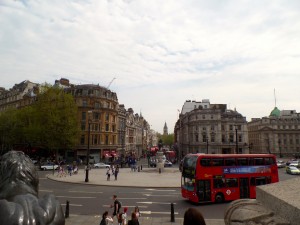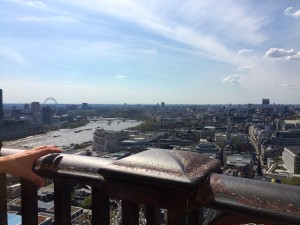As we walked through the German History Museum, I was surprised by the objectivity of its presentation. Throughout this trip, we have visited numerous museums, each with different methods of presenting information. In my opinion, the French museums glossed over information the most, – indicative of their history of ignoring France’s collaboration and the Holocaust – the Schindler Museum in Poland was the most nationalistic, and the Churchill War Rooms in London were able to be objective because they held no blame in the Nazi narrative. I expected the German museums to be as nationalistic as the Schindler museum and as inexplicit as the Caen Memorial. I was pleasantly surprised to be wrong.
The German History Museum did not conceal the facts of Germany’s past. From the start, the modern war exhibit discussed World War I and explained the German defeat. The displays and audio guide walked you through the Treaty of Versailles and the consequences of the public’s ignorance to the true German position at the end of the war. It explicitly mentioned the anti-Semitism and anti-bolshevism that already existed in German society and how it increased after the war. Being that the German public at the time were entirely ignorant to the means of their defeat, I was happy to see that this is no longer the case.
Further into the exhibit the rise of Hitler and the National Socialist Party was expressed through facts. This was strikingly different from the entrance to the Caen Memorial with its descending stairway to hell. I say “descending stairway to hell” because the entrance to its main exhibit was a downward spiraling ramp that depicted the rise of Nazism as evil. Although facts were presented, the spiral made heavy use of mise-en-scène, a term we discussed in Dr. Davidson’s class. Mise-en-scène refers to a style of visual production that is meant to lead your mind in a particular way. At the Caen Memorial, this was accomplished through a gradual change in the wall’s material, from smooth and white to dark and rough, as well as many pictures, posters and videos of the Nazis rise to power. By the time you got to the bottom of the spiral, you could look up and see the difference between the first, stark white wall and the final wall that resembled a jagged rock. At the German History Museum, there was no such thing. All of the facts were presented in sequence with explanations of their significance, but then you were free to interpret them however you chose.

The contrast between the wall gradient at the beginning of the Caen Memorial to the bottom of the spiral.

The descending spiral at the Caen Memorial made heavy use of mise-en-scène. The walls were covered in media showing the rise of Hitler and the Nazis. In this picture you can see the contrast in gradient of the walls.
The German History Museum’s exhibit was comprehensive. Not only did it include World War I and the Nazi’s rise to power, but also the tactical aspects of the war, the same model of Auschwitz II- Birkenau on display at the camp, and the extensive Nazi propaganda. I was excited to see the posters for films we watched in Dr. Davidson’s class and thoroughly intrigued by the high degree the Nazis went to indoctrinate the German people. There were even dollhouses with pictures of Hitler in their living rooms and wallpaper displaying scenes of Hitler Youth. The Nazis truly tried to cover every audience.

The dollhouses produced during the Nazi Era had framed pictures of Hitler hanging in the living rooms.

A poster for La Habanera, a film we watched in Dr. Davidson’s class that portrayed the Aryan race as morally superior to others.
As I mentioned, there was a scale model of the crematoriums at Auschwitz II-Birkenau included in the exhibit. Although it caught me off guard, I was pleased to see that it was included in the museum. The audio guide we used throughout the exhibit often had a children’s version. So out of curiosity, a few of us listened to the children’s version about the crematorium model to see what the nation was teaching its children. The audio was extremely explicit, using words like murder and describing the process of going from the undressing rooms to the gas chamber to the crematorium. The adult version was even more detailed. Though even we thought this may have been too much for children to handle, we were impressed that the museum was going to such lengths to teach their people from an early age about the Holocaust. Later, Dr. Davidson shared that most German school children are required to visit a holocaust site several times throughout their education as a part of their curriculum. Overall, I was very impressed with the German History Museum’s objective presentation and Germany’s commitment to owning up to its past.










